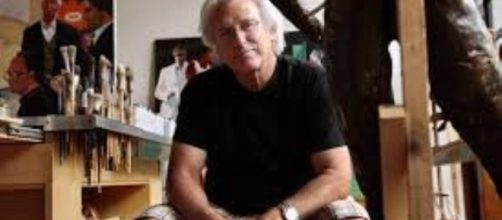You don’t see this very often – art about aging. There are plenty of paintings and sculptures about loss and even about death, but few bear witness to growing old. Maybe that’s because so many artists failed to live long enough to experience their advanced years. Age 37 seems to be the cut-off year for several painters, such as Raphael, Watteau and Van Gogh. A longer list shows even shorter life spans: Giorgione, Gericault, Seurat, Modigliani, Schiele, Hesse, Klein, Haring, and Basquiat. Causes of these deaths vary from tuberculosis, the plague, meningitis, murder, Spanish flu, brain tumor, heart attack, AIDS and heroin overdose.
It’s worth mentioning that suicide is not on these lists.
‘Face-Off’
All of which makes Eric Fischl’s new paintings especially notable. “Face Off,” one of five large canvases about aging, tells his own story at age 68, facing his mortality. At first, what you see seems obvious: the disparity of a boy and an elder. The divide between child and senior is almost too self-evident to be interesting. But the face-off between these figures is layered with knowing. The boy is skinny and ungainly with a faltering posture as he stands on the stone deck of a swimming pool, while the older figure stands stoutly in the water. You can take it from there. Fischl sets the scene. The deck is pristine white, suggesting the youth’s innocence.
It’s also rock hard, inferring his limitations as a child. In contrast, the blue water is richly colored and flowing, indicating life itself, unfixed.
Light of day
Another thing about Fischl’s work that calls out is the painting style – naturalistic, sort of a painterly photo-realism; except the brushwork looks hurried and insistent, as if driven, lending the imagery an immediacy that turns it momentous.
You can’t look away. Fischl won’t let you. The light on the deck and on the water is so harsh, so pitiless, that even though the action takes place on a sunny day, the shadows take on an ominous air...and that’s when they become unsettling. The uncertainty of life looms large here.
Seeing more
While there’s zero connection between this painting by Fischl and sculpture, one of Rodin’s works, “La Belle Heaulmiere,“ a.k.a.
“The Old Woman,” parallels it. Like “Face-Off,” Rodin paid mind to the coming end of life with a wrinkled and bent female mourning her Lost Youth He modeled the figure from an actual octogenarian and from a Francois Villon poem about “traitorous old age.” The title of the sculpture is taken from the title of the poem, which reads in part: “When I think wearily on what I was, of what I am, when I see how changed I am – poor, dried-up, thin - I am enraged!” By comparing the painting to the sculpture, you can see that Rodin’s take on life is one-dimensional and Fischl’s seemingly simplistic version has more to say.


